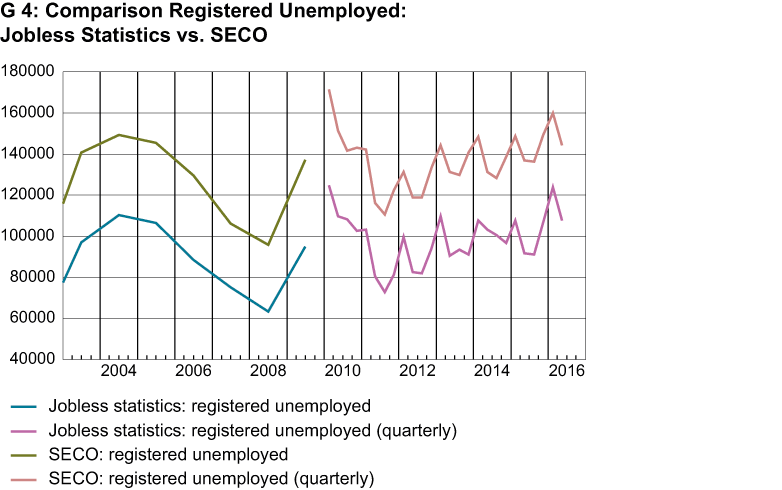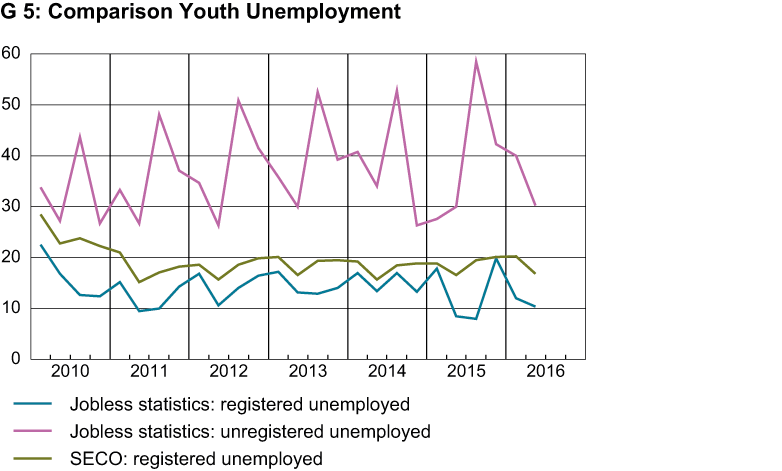Please Count All of the Unemployed
- Labour Market
- KOF Bulletin
The jobless statistics and SECO’s registered unemployment statistics show a very similar trend if the count only includes the unemployed population that is registered with an employment office. With the number of long-term unemployed rising, the jobless statistics are going up – a phenomenon that the SECO statistics do not reflect since many unemployed are not registered with a job centre.

Is long-term unemployment rising in Switzerland? There is no straightforward answer to this simple question. This is due to the fact that Switzerland publishes not one but two unemployment statistics (see Siegenthalter, 2013). They paint different pictures of the trend in long-term unemployment over the last few years. One of them, the registered monthly unemployment statistics, is calculated by the State Secretariat for Economic Affairs (SECO) on the basis of registration data collected by the regional employment offices (RAV). The annual average last year was 3.2 per cent. For many years, these statistics have shown little change in the long-term unemployment rate.
The ‘jobless statistics’ calculated by the Federal Statistical Office (FSO) present a different picture. Here, unemployment is calculated according to the definition of the International Labour Organisation (ILO). To determine this unemployment rate, around 130,000 telephone interviews are conducted every year among the permanent resident population, both Swiss and foreign, in the context of the Swiss Labour Force Survey (Schweizerische Arbeitskräfteerhebung, SAKE). Pursuant to these statistics, unemployment amounted to 4.5 per cent in the past year and had followed an upward trend in the preceding years due, in particular, to a rise in long-term unemployment.
Surprisingly accurate jobless statistics
The public often regards jobless statistics with scepticism. Is this scepticism justified? The answer is no, for two reasons: Firstly, the two statistics provide a similar assessment of the number of registered unemployed. This is not a matter of course since the jobless statistics are based on random sampling among households and may therefore be subject to statistical fluctuation – which does not typically occur in the registered unemployment statistics that are calculated on the basis of registration data. Furthermore, due to their collection method, the statistics might deliver systematically distorted results, for instance since the unemployed may be easier to reach by telephone than people in employment.
Graph G 4 presents the number of people who, according to the jobless statistics, are unemployed and registered with a RAV at the same time (blue line). It also shows the number of unemployed according to SECO’s registered unemployment statistics. We observe that both lines have followed a very similar trend since approximately 2002. This is true for both the long-term and the quarter on quarter development – a measurement that has been possible since 2010 when quarterly SAKEs were introduced. The biggest difference in the two series consists of the level of registered unemployment. Detailed but unpublished analysis by the FSO, which is based on a comparison of various data sources, indicates that this difference in levels is not due to any undervaluation of registered unemployment in the SAKE sample. Instead, among other factors, the SECO statistics appear to include a considerable number of persons who are at least partially employed.
Around 40,000 unregistered unemployed youths
Scepticism regarding the jobless statistics are furthermore unjustified because they are in fact conceptually superior. In contrast to the registered unemployment statistics, the jobless statistics also include unemployed persons who are not registered with an employment office. This is a central difference since over half of all unemployed in Switzerland are not registered with a RAV. In 2015, around 120,000 jobless persons were not registered with a job centre. This number has been rising steadily over the last ten years. A KOF Study on unemployment in Switzerland shows that the tendency to register with a RAV in the case of unemployment is below average among women, young people and people with low education levels (Bolli et al., 2015). The SECO statistics therefore underestimate their percentage.
Graph G 5 uses the example of youth unemployment to illustrate the relevance of this undervaluation. The graph shows the number of registered and unregistered unemployed aged 15 to 24 according to the jobless statistics and, for comparative purposes, the number of registered unemployed youths of the same age according to the SECO statistics. The comparison shows that around 10,000 to 20,000 unemployed youths have been registered with RAVs every quarter since 2010. However, in each quarter, there were also between 25,000 and 60,000 unemployed youths that were not registered with any job centre. It is also striking that the jobless statistics always show a significant surge in the number of unregistered unemployed youths in the third quarter of each year, which subsequently declines on a gradual basis. This is not surprising since many students and apprentices complete their education in the third quarter and start looking for jobs. Apparently, only a small percentage of these young people register with a RAV.
Long-term unemployment at record level
The above considerations raise the question why some unemployed persons do not register with a job centre. There are numerous reasons which have not yet been conclusively researched at the international level. One key explanation consists of a lack of awareness among some jobless that they are actually entitled to benefits. For others, visiting an employment office carries a social stigma. Furthermore, the probability that unemployed persons register with a RAV is higher the easier it is to draw unemployment benefit and the higher this benefit is.
However, in Switzerland, one of the main reasons for the failure to register is a lack of entitlement to benefits. This applies, on the one hand, to persons who do not meet the conditions for drawing unemployment benefit although they are jobless. They consist, in particular, of unemployed who did not work for long periods or on a regular basis before their unemployment commenced. On top of that, some persons have been unemployed for so long that they cease to qualify for unemployment benefits (‘Ausgesteuerte’). Only around one third of the ‘Ausgesteuerte’ who continue to actively look for a job are still counted as registered unemployed one year after they lose their entitlement.
This specifically results in an undervaluation of long-term unemployment in the registered unemployment statistics. According to the jobless statistics, the number of long-term unemployment is higher in 2016 than ever before – a development that the SECO statistics do not reflect. The reasons for this rise in long-term employment have not yet been systematically researched.
2011 revision of unemployment insurance ‘reduced’ measured employment
As a direct result of the factors above, the specific form of the current unemployment insurance system has an impact on the question whether unemployed persons are registered with a RAV or not. The year 2011, when the conditions for unemployment benefit claims were tightened in the course of the fourth unemployment insurance revision, shows that this is a relevant aspect. The reform led to a substantial decline in the proportion of unemployed who are registered with a RAV. The percentage of registered unemployed according to the ILO was 54.3 per cent in the quarters before the revision of the law (first quarter 2010 to first quarter 2011). After the reform, this figure declined to 46.4 per cent (second quarter 2011 to first quarter 2016). In other words: The level of registered unemployment would be higher today if the pre-reform unemployment insurance regulations still applied. The effect is particularly striking in terms of the measured long-term unemployment rate since, in the course of the reform, over 16,000 long-term unemployed had their entitlement terminated in March 2011 and were consequently no longer included in the SECO statistics. The 2011 reform is one of the reasons why the SECO unemployment statistics fail to reflect the increase in long-term unemployment in Switzerland.
Literature
Bolli, T., C. Breier, U. Renold und M. Siegenthaler (2015): Für wen erhöhte sich das Risiko in der Schweiz, arbeitslos zu werden?, KOF Studien, 65, Zürich, Juli 2015.
Siegenthaler, M. (2013): external page Die «Erwerbslosenquote» ist die eigentliche Arbeitslosenquote, Ökonomenstimme.
Contact
KOF Konjunkturforschungsstelle
Leonhardstrasse 21
8092
Zürich
Switzerland

